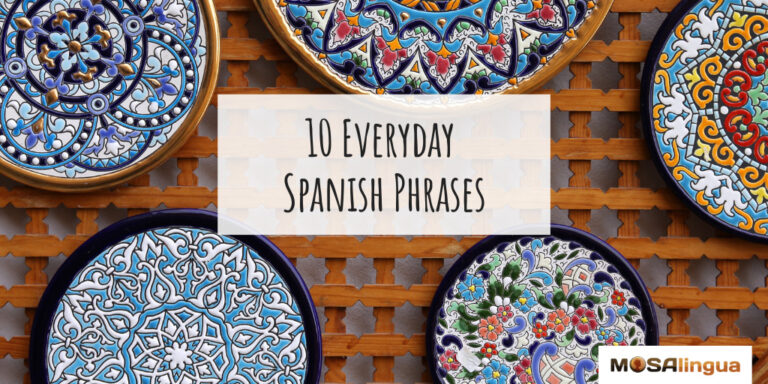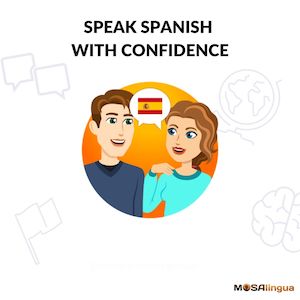If you walk down the street in a Spanish-speaking country, it’s almost guaranteed that you’ll hear a word or phrase you haven’t learned yet. The best way to get a good grasp of everyday Spanish phrases and expressions is to interact with native speakers. After all, when we learn a language, our main goal is to communicate with people and to get through daily tasks, right? So we’ve put together a list of 10 common Spanish phrases that will help you get through your daily routine in Spain sounding like a native speaker. ¡Vamos!

10 Everyday Spanish Phrases You Should Know
¡Buenas!
“¡Buenas!” is a very common and casual way to greet someone in Spanish. It’s a combination of hola (hi) and “qué tal” (How’s it going?), and it’s considered a very friendly way to acknowledge someone.
No need to worry about the differences between “buenos días” (hello, but only in the morning), “buenas tardes” (hello, in the afternoon) or “buenas noches” (good evening). Buenas covers all of these expressions!
¿Qué tal?
Many people learning Spanish ask “¿cómo estás?” when they’re starting a conversation with someone. But in reality, this can come off as a little strange because the question “¿cómo estás?” (How are you?) typically implies that you’re expecting a candid and truthful answer, whether the person you’re speaking with is doing well or not.
“¿Qué tal?” is a more informal expression that’s used to greet friends and family. People typically reply to this question with “¡Muy bien! ¿Y tú?” (Very well! And you?) or “Bueno…” (Good…).
No sé…
If someone asks you a question and you don’t know the answer, this basic Spanish expression will save you!
“Do you want to go to the beach or to the mountains?” “¡No sé!” (I don’t know!).
You can also use it when you’re not sure about something.
“Should we go to the cinema to see a scary movie?”
“No sé… No me gustan las pelis de miedo.” (I don’t know… I don’t like scary movies.)
Por cierto…
This is a very useful expression for introducing new information or changing the subject of a conversation. Spanish people use it without thinking!
“Por cierto” (By the way…), how many expressions have we learned so far? That’s right, four!
¿Cuánto es?
If you’re traveling in a Spanish-speaking country, you’ll need to be able to ask how much something costs. This expression will be useful if you’re trying to ask for your bar tab, or if you’re shopping for new clothes. You can ask “¿cuánto es?” (How much is it?).
It’s shorter and simpler than saying “¿cuánto cuesta?” (How much does it cost?). And it’s more natural!
Improve your spoken Spanish

Good news: we have a course for that! The Speak Spanish with Confidence MasterClass.
It’s a comprehensive 8-module course designed to help you improve every aspect of your spoken Spanish – fluency, confidence, pronunciation, and more – step by step, and enjoy doing it.
Quiero…
This is an important word for expressing what you want in Spanish. Learn it early – it’ll serve you well!
- “Quiero un café, por favor” (I’d like a coffee, please.)
- “Quiero encontrar un buen trabajo” (I want to find a good job.)
- “Te quiero” (I love you.)
As you can see, this word is used in all kinds of different contexts and is almost always followed by an infinitive.
Perdona
“Perdona” is another everyday Spanish expression that you can use in many different situations. You can use it to get someone’s attention. For example, if you’re trying to wave down a server to order a coffee.
But you can also use it to ask people to let you through a crowd, or to apologize if you’ve accidentally bumped into someone:
- “Perdona, ¿me dejas pasar?” (Excuse me, could you let me through?)
- “¡Perdona!” (Sorry!)
You can also use this word if you didn’t understand something someone said: “¿Perdona?” (Pardon?).
Or even if something surprises you in a negative way: “¿¿Perdona??” (Excuse me?!).
¿Dónde está… ?
You can use this expression when you’re looking for something but don’t know the way. For example:
- “¿Dónde está la estación de metro?” (Where is the metro station?)
- “¿Dónde están mis llaves?” (Where are my keys?)
Be careful – lots of Spanish learners say “¿Dónde es?” which is incorrect. Check out these other common Spanish mistakes so you can avoid them at all costs!
Ya…
This word is super useful if you’re having a conversation and you want to show the other person that you’re following:
- “Cuando llego a casa estoy agotada…” (When I get home I’m exhausted…)
“Ya…” (Yeah…)
“Así que me pongo un poco de música relajante” (So I put on some relaxing music.)
“Ya…” (I see…)
Or, you can also use this word to say you agree:
- “¡Qué mal huele!” (That stinks!)
“¡Ya!” (I know!)
This is a very handy – and common – word in Spanish!
¡Hasta luego!
When you’re saying goodbye to someone, you can express that you hope to see them again at some point. Instead of simply saying adiós (goodbye), you could say “Hasta luego” (See you later). This is much more common and natural sounding in Spanish. You can also say it over the phone. Or when you meet a person you know on the street but you can’t stop to chat with them: “¡Hasta luego!”
A final tip: Start using these expressions as soon as possible to incorporate them into your vocabulary foundations. Practice is the best way to learn!
Watch: 10 Spanish Phrases for Daily Use [VIDEO]
You can also learn about these ten everyday essential Spanish phrases and their pronunciation in Mirari’s video. The video is in Spanish, but there are subtitles in Spanish, English, French, German, Italian, and Brazilian Portuguese. You can also adjust the playback speed if it’s too fast by clicking the settings gear at the bottom right.
Subscribe to our YouTube channel!
Next Steps
If you liked this article on everyday Spanish for beginners, you might also enjoy:




Comments